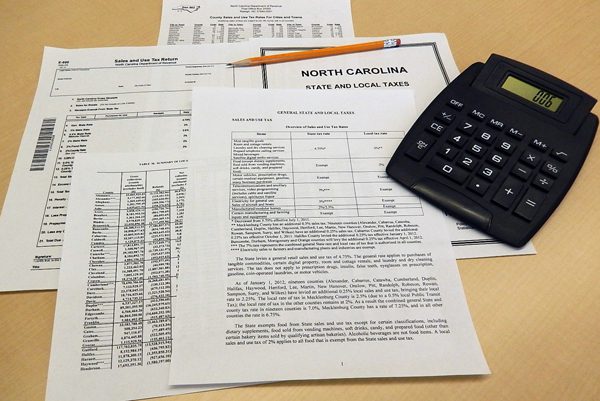N.C. tax reforms: 1921, 1933 and maybe 2013

The Revenue Act of 1921 put the Tar Heel State on a then-new path by replacing its old and failing state property tax with the modern income tax. In the Emergency Revenue Act of 1933, as incomes and tax revenue sank into the depths of the Great Depression, state policymakers established the retail sales tax to stabilize revenue.
Today, income and sales taxes are the predominant sources of state tax revenue. Nevertheless, two Mecklenburg state senators, Democrat Dan Clodfelter, and Republican Bob Rucho, seek major redesigns of North Carolina’s tax system.
|
For more information See more details on each proposed tax plan here. |
Clodfelter’s plan would broaden the sales tax base somewhat and improve the design of income taxes. In contrast, Rucho would replace income taxes with a much broader sales tax on all retail sales, including retail services. Each plan has strong and weak points. To assess those points, it helps to understand the principles of sound taxation.
First, taxes must generate revenue sufficient to finance public services. Demand for public services grows along with the economy, so to remain sufficient requires that tax revenue follow the economy’s upward trend.
Second, the tax system should be relatively stable amid economic expansions and contractions.
Third, the tax system should be fair: That is, taxpayers with similar incomes should face similar tax liabilities. And, it is commonly argued, tax liability should increase somewhat faster than income: In other words, taxes should be progressive.[1]
Fourth, the tax system should be as economically efficient as possible. If two tax structures bring in the same revenue but one intrudes more into economic decisions, it is more inefficient. Inefficient tax structures cause substitutions from commodities with relatively high economic value to those with lower value. For example, Old England once imposed a tax on windows. So the English began to build houses with fewer windows. Today, much modern capital, such as intellectual property, is intangible. This makes it particularly easy to shift capital into investments taxed at lower rates, which is inefficient.
Finally, tax administration and compliance should be as simple as possible.
How does North Carolina’s tax system stack up? Not so well. Here’s why,
First, today’s tax system cannot generate sufficient revenue in the long run. Sales tax generates about 31 percent of the general revenue. Sales tax is levied primarily on tangible goods, such as clothing. As a fraction of total spending, services such as health care are replacing tangibles in household budgets. Thus the sales tax base is withering.
Second, state tax revenue follows the roller-coaster path of the economy, swinging widely from recessions to expansions. Revenue instability has been caused in part by taxing tangibles, which are much more responsive than services to economic contractions. The erosion of the sales tax base also causes instability, which creates heavier reliance on income taxes. Income taxes also are relatively unstable.
Third, the tax system is perceived as unfair. One reason is that North Carolina taxes are not as progressive as some would like. Another is that tax deductions for charitable contributions, medical expenses, etc., are based on taxpayers’ highest marginal tax rate. Upper income taxpayers face the highest marginal tax rates, so they enjoy larger deductions than low earners, even if the dollar amounts of deductions are equal. Further, certain businesses and activities get special treatment.
Fourth, relatively high marginal tax rates create inefficiency, because they distort economic choices. High sales tax rates on goods favor services, which exacerbates the shift away from taxable tangible goods. High income tax rates encourage the wealthy to find ways to avoid taxes. That is one reason stock options have replaced substantial fractions of wage income for high earners and why deferred income arrangements are popular.
Fifth, today’s system is unnecessarily complicated.
Clodfelter and Rucho have each proposed tax restructuring plans. Both plans are designed to keep today’s level of tax revenue.
Clodfelter’s plan would reduce the state sales tax rate from 4.75 percent to 4.5 percent and extend it to many services not now taxed. (Note: Counties can also impose sales taxes, on top of the state rate.) It would cap the personal income tax rate at 6 percent, repealing the 7 percent and 7.75 percent marginal rates. Clodfelter’s plan would add a large income tax exemption, plus make changes in deductions and tax credits. For details, click here.
Rucho’s plan would gradually replace the personal and corporate income taxes, over a period of years, with a broad-based retail sales tax. Until the sales tax brings in enough to fully replace income tax revenues, households could exclude the first $15,000 in income from the income tax. Ultimately, the combined state plus local sales tax rate would be 6.5 percent in most counties. The current rate is 6.75 percent. It would also eliminate some forms of business taxes and expand others. For details, click here.
Would the benefits of those proposals repay the effort required to implement them? I believe they would. Simply extending the sales tax broadly to services and currently exempt goods would produce many economic benefits.
First, because services tend to grow with the economy’s long-run trend, a wider sales tax could become a sustainable revenue source. Extending sales tax to nearly all services, as Rucho proposes, would all but eliminate sales tax base erosion.
Second, because spending on services is less volatile than income and spending on tangibles, it would increase revenue stability.
Third, because, if every other factor is held constant, high earners tend to spend proportionately more income on services, extending the sales tax would tend to increase progressivity. But by eliminating income taxes, Rucho’s proposal would tend to reduce progressivity. Rucho argues this effect would be offset by an increase in economic growth after his plan goes into effect. This remains to be seen. In the past, forecasts of faster growth post-reform have proven overly optimistic.
Clodfelter would reduce the corporate income tax and eliminate the top two personal income tax brackets, which reduces progressivity, but by a smaller amount than Rucho’s plan. Clodfelter’s proposed income tax exemption would tend to offset this reduction, as would replacing tax deductions with tax credits for personal income taxes. Clodfelter’s plan would extend the franchise tax to limited liability companies (LLCs), which would reduce tax inequities on different types of businesses. However, the franchise tax base is complicated. Rucho’s proposal, to replace it with a business license tax on all firms, would reduce inequities and simplify business taxes.
Both plans would reduce marginal income tax rates, improving efficiency. Importantly, Rucho’s plan, unlike Clodfelter’s, would shift the tax base away from income toward consumption. Consumption taxation is more efficient than income taxation because it does not tax capital investment.
But what about tax simplification? Both plans would complicate tax collecting by extending the sales tax to more services. However, by eliminating income taxes, Rucho’s plan includes an element that would greatly simplify taxes.[2]
Twice during the 20th century North Carolina responded to major economic transformations that had undermined its tax system. Those changes made the tax system appropriate to the times. Since then, the evolving economy has undermined those earlier reforms. Clodfelter’s and Rucho’s plans both address those issues, but in different ways: Clodfelter would reform the income tax, Rucho would replace it.
Like the two senators, North Carolinians may differ on the best approach, but there should be no disagreement on the necessity for reform.
Benjamin Russo is a professor of economics at UNC Charlotte. He can be reached at brusso@charlotte.edu.
Editor’s Note: This article compares plans for tax reform introduced in the N.C. Senate. Today (May 16) N.C. House Republicans offered their own plan for tax reform. To read more about the House plan, click here.
[1] There is some confusion about Adam Smith’s views about tax fairness. In the Wealth of Nations, Book 5, Chapter II, Part II, On Taxes, Smith states “The subject of every State ought to contribute towards the support of the government …in proportion to the revenue which they respectively enjoy….” But 16 pages later he adds, “The rich should contribute to the public expense, not only in proportion to their revenue, but something more than in that proportion.”
[2] Slemrod and Bakija report estimates of the size of such costs. See Taxing Ourselves (MIT Press: Cambridge, Mass.)
Benjamin Russo